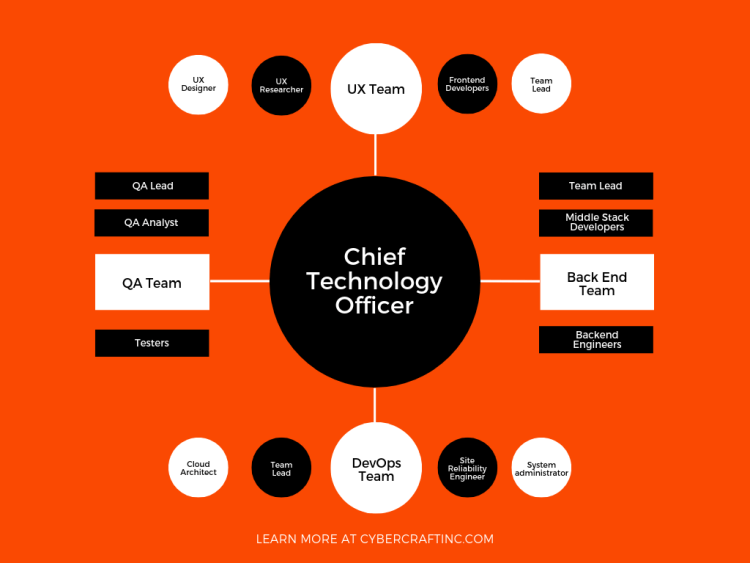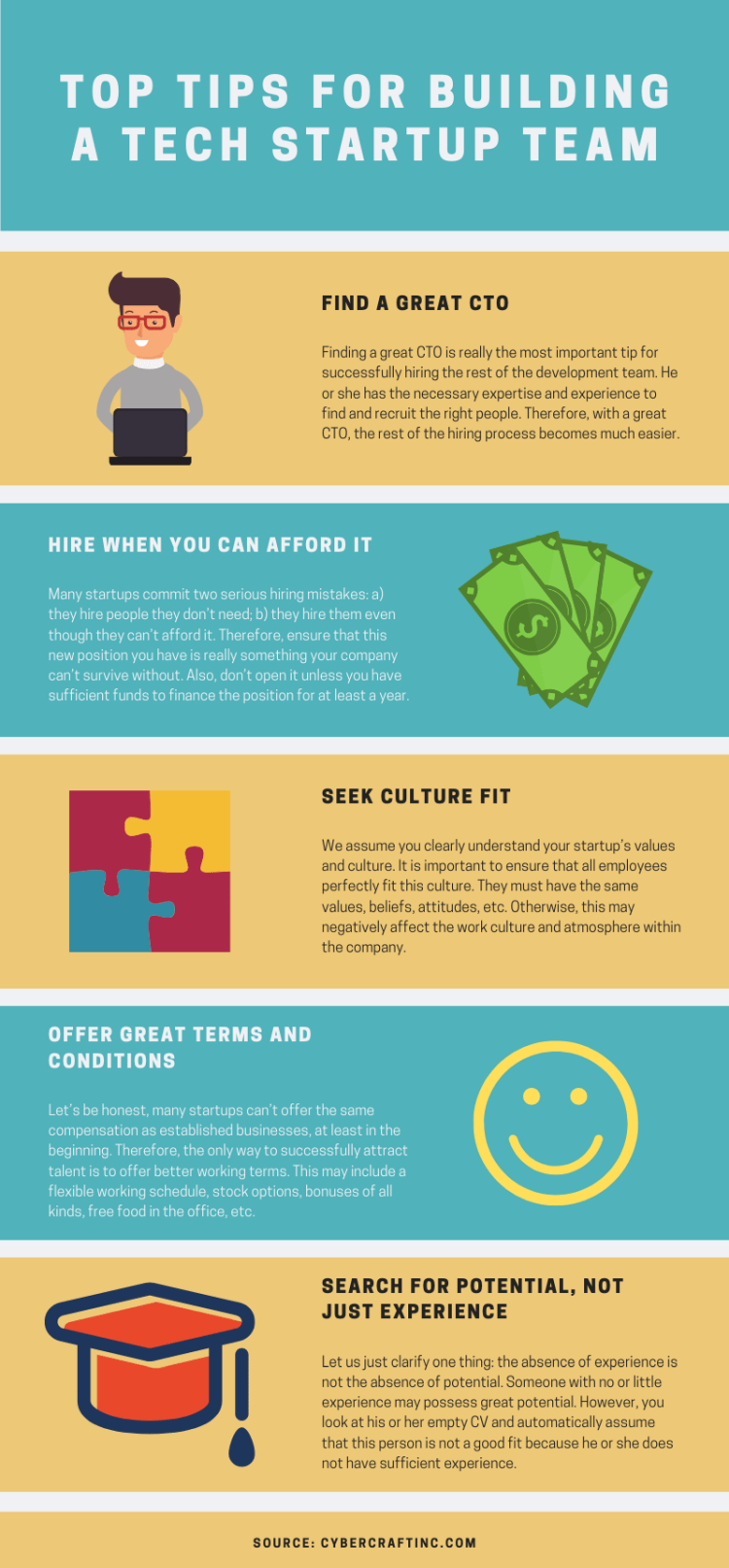Startup Roles & Responsibilities
What are the key startup roles and responsibilities? How to correctly set up your tech startup development team? What is the right startup organizational structure for its development team? If you’re asking these or similar questions, you’ve come to the right place. In this detailed article, we will present and analyze an ideal startup team structure and explain how to successfully build such a team.
Organization structure for startups is vital for success. This is even more so when it comes to the development team which is an inseparable part of any tech startup. An incorrect structure may lead to miscommunication, decreased productivity and disrupted workflow.
For this reason, it is important to take one’s time to diligently and carefully design the most effective startup org structure. Below we will present our proposed ideal structure of a development team for a tech startup.
Ideal Tech Startup Organizational Structure

In our view, there are two most important roles in a startup company – Chief Executive Officer or founders and the Chief Technology Officer. These two key roles in a startup are at the top of our structure and have two distinct areas of responsibility. The CEO is responsible for:
- Marketing & sales
- Legal stuff
- HR
- General management
- Supervising and communicating with the CTO
The CTO, in turn, (at least in our case) supervises four mini-teams, namely:
- UX team
- Backend team
- DevOps team
- QA team
Therefore, the development team is broken down into four mini-teams each with its distinct areas of responsibility. We’re going to analyze each of these teams, startup roles, and titles in detail below.
UX Team
User experience team is an essential part of almost any startup. It is responsible for creating the best possible experience for users through smart & aesthetic design and front-end development. It also cooperates with other mini-teams to achieve the set goals. In our proposed model, the UX team includes the following startup team members:
- UX researcher
- UX designer
- Frontend developers
- Team leader
Some people may not be well familiar with the UX researcher role and not understand what it implies and why it is necessary at all. After all, is not having a great UX designer enough? Successful cases such as Airbnb and Google (which hire UX researchers) prove that UX research is vital for great user experience and product success. Therefore, hiring talented UX researchers may greatly contribute to your startup success. However, the question remains: what does a UX researcher do?
A UX researcher analyzes user behavior and draws corresponding conclusions and provides valuable insights based on that behavior. These insights allow the rest of UX team to implement effective and successful UX design which users absolutely love.
In our model, a UX researcher provides the needed insights to help the UX designer create the right mockups and designs based on the information provided by the UX researchers. These two, in turn, work with the front-end developers who use those insights and designs to build the front-end. Finally, the team leader manages them all and coordinates all collaboration within the UX team.
Backend Team
Pretty much everyone in the tech world understands what a backend team is and what it does. This team is the most important one in the entire development department. It is responsible for the core of the application being built and app logic interacting with cloud services as well as the backend’s interaction with the front-end through API Endpoints. Our proposed backend team structure is the following:
- Team lead
- Middle stack developers
- Backend engineers
The team lead manages backend developers and coordinates the collaboration and workflow. Some readers might question why we included middle stack developers. We believe that this will help improve the connection between frontend and backend i.e. the middle stack developers will serve as the missing link between the two ends. This will allow both front-end and back-end developers to focus on their core work without having to worry about that middle layer and bother with API Endpoints, etc.
DevOps Team
The key responsibility of the DevOps team is cloud infrastructure management. They are responsible for adding new code to the repository before deployment of each new version and diligently testing the new code. Fast time-to-market and perfect user experience are the major objectives of the DevOps team. We propose the following DevOps team structure:
- Team lead
- Cloud architect
- Site reliability engineer
- System administrator
The lead manages the DevOps team, assigns tasks and responsibilities within the team, and controls the workflow. The cloud architect is responsible for building and managing cloud infrastructure. The SRE specialist ensures stable and uninterrupted performance of the apps and systems. The system administrator is responsible for cloud monitoring and support.
QA Team
The quality assurance team is responsible for testing the application being built to ensure the absence of any bugs, errors and stable & efficient performance. As such, it includes the following stakeholders:
- QA Lead
- QA Analyst
- Testers
The QA lead manages and supervises the QA team. He or she sets quality metrics & standards for quality assurance of the product being built and ensures that those standards are met. The QA lead ensures that all queries are resolved on time. Other responsibilities include defining testing strategies, scheduling and assigning tasks among many other things.
The QA analyst creates, manages and executes test plans for both manual and automatic testing. He or she produces the required documentation at all stages of testing and designs test suites. Finally, the testers do just that – execute and run tests. They review and analyze system specifications, execute test scripts, review results, and report to the analyst and QA lead.
Having reviewed our proposed structure of an ideal development team for a tech startup, let’s talk about how to build such a team for your project or company.

How to Form a Team for a Startup?
Finding the right people for your development team is not always an easy task. Basically, you have a few options here:
- Full in-house team
- Partial outsourcing/staff augmentation
- Complete outsourcing/dedicated development team
Which option is best for you depends on your priorities, goals and specific circumstances. Let’s analyze each of these options in detail.

Full In-House Team
One of the classical options is to build a complete in-house team of local developers. At first, it seems like the most reasonable option as you have direct control and it’s easy to manage the team.
However, it also creates specific disadvantages such as higher development and operational costs. First, if your startup is based in the Silicon Valley or even anywhere in the US, Canada, UK or some other developed country, then developer salaries are likely to be quite high compared to the rest of the world.
Having full-time employees also creates additional costs such as payroll taxes, employee benefits, etc. Furthermore, don’t forget about operational costs such as office space, equipment, etc. In the end, all of these expenditures can significantly add up to your overall costs.
Therefore, although a full in-house team may be the best option in many cases, it’s likely to be the most expensive option for startups.
Partial Outsourcing
A very popular option among startups is to combine an in-house team with partial outsourcing or remote developers. In the case of outsourcing, a startup selects a certain area of work which it outsources to an offshore software development company. The latter does all the work including management of the project. The startup simply provides technical specifications and requirements.
As for the second option, remote developers, a startup selects specific full-time positions which it finds remote employees for. It turns to a staffing company which finds and recruits the needed remote developers for the startup.
The new remote employees become a part of the team but work at the staffing company’s office. The latter serves as the official employer of the remote developers and fulfills its obligations as an employer such as salary, paying taxes, providing various employee benefits, etc. With this model, you can hire multiple remote developers and organize them into dedicated development teams.
Many Silicon Valley startups use remote developers. They hire full-time remote developers with the help of IT staff augmentation companies. If you’d like to learn more about the difference between IT staff augmentation and managed IT services (outsourcing) check our other article, Managed IT Services vs. IT Staff Augmentation: A Detailed Comparison.
Complete Outsourcing or a Dedicated Development Team
Finally, some entrepreneurs may want to try complete outsourcing and abstain from in-house development. Another option is to hire a dedicated software development team. Unlike partial staff augmentation when one hires remote developers for a few select positions, a dedicated team can take on all the development work. This team is almost identical to your in-house team except they are based abroad and work at the staffing company’s office. Such a model usually provides significant cost savings.
Finally, let’s also review some crucial tips for building your development team.
Top Tips for Building a Tech Startup Team
Here are the key startup hiring tips you need to take into account when building your development team:
- Find a great CTO
- Hire when you can afford it
- Seek culture fit
- Offer great terms and conditions
- Search for potential, not just experience
Let’s see why each of these tips is worth considering.

Find a Great CTO
Finding a great CTO is really the most important tip for successfully hiring the rest of the development team. He or she has the necessary expertise and experience to find and recruit the right people. Therefore, with a great CTO, the rest of the hiring process becomes much easier.
Hire Only the People You Need and When You Can Afford It
Many startups commit two serious hiring mistakes: a) they hire people they don’t need; b) they hire them even though they can’t afford it. Therefore, ensure that this new position you have is really something your company can’t survive without. Also, don’t open it unless you have sufficient funds to finance the position for at least a year.
Seek Culture Fit
We assume you clearly understand your startup’s values and culture. It is important to ensure that all employees perfectly fit this culture. They must have the same values, beliefs, attitudes, etc. Otherwise, this may negatively affect the work culture and atmosphere within the company.
Offer Great Terms and Conditions
Let’s be honest, many startups can’t offer the same compensation as established businesses, at least in the beginning. Therefore, the only way to successfully attract talent is to offer better working terms. This may include a flexible working schedule, stock options, bonuses of all kinds, free food in the office, etc.
Search for Potential, Not Just Experience
Let us just clarify one thing: the absence of experience is not the absence of potential. Someone with no or little experience may possess great potential. However, you look at his or her empty CV and automatically assume that this person is not a good fit because he or she does not have sufficient experience.
While in some cases, this may be correct, you should also consider if this person has potential. Sometimes hiring someone with no experience but with huge potential may prove a great decision, especially for startups.
Conclusion
The right team structure is essential for startup success. Correctly delegating essential roles in a startup is a must, especially within the development team. In this article, we proposed and described our own startup organizational structure. First, we suggested that the CEO manages marketing & sales, legal, HR, and other non-tech areas. The CTO, in turn, should manage four mini-teams: UX team, backend team, DevOps and QA teams.
Finally, we described the best options for building a development team for a startup and provided the best startup hiring tips. If you’re looking to hire remote dedicated software developers for your company then get in touch with CyberCraft today – fill out the form below and receive a free consultation with a detailed estimate!




